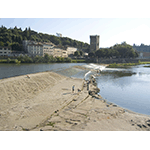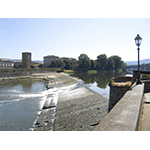San Niccolò Weir - Arno
Since antiquity and throughout the 14th century, the Arno was one of Florence's major resources for producing energy for the water-driven manufactories along its course. The river was also exploited for fluvial transport and as a natural supply of water for the city. The Wool Merchants' Guild owned numerous facilities on the river, such as a fulling mill, used in the various cycles of processing wool and fabrics. The so-called "pescaie" or "steccaie" made of wood or vegetal material contributed to the work of channelling the river. There were two main Florentine weirs: the Pescaia di San Niccolò, situated in the vicinity of the gate of the same name, and that of Santa Rosa near the Parco delle Cascine. The San Niccolò weir furnished water, destined in part to the needs of the population, to the mills located inside the walls.
Between 1836 and 1837, in the vicinity of the weirs, a suspended bridge was built over the Arno, supported by metal cables stretched from one bank to the other, and named San Ferdinando in honour of Grand Duke Ferdinand III. At that time, the use of iron in constructions was laying the bases for a new relationship between art, technology and industry. The bridge was built by the French firm headed by the brothers Marc and Jules Séguin, famous engineers expert in designing metal bridges, who had also been commissioned to build the other iron bridge in Florence (Ponte San Leopoldo). Only a few years after its inauguration, the San Ferdinando Bridge was washed out by the great flood of the Arno in 1844. In 1853 it was rebuilt, then to be replaced in 1890 by another metal bridge of three spans, it too no longer existing today. With the fall of the Grand Duchy, it was named San Niccolò for the nearby quarter, a name that has been retained for today's single-span reinforced concrete bridge, built after World War II.
****************************
Texts by Antonella Gozzoli
English translation by Catherine Frost
Last update 15/gen/2008





